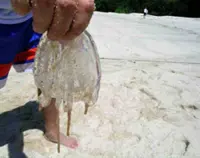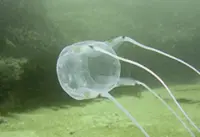Pain bearers: The 35 highly venomous box jellyfish netted along Batu Ferringhi after marine scientists towed a special net for 650m at about 200m from the shoreline on Jan 12.
GEORGE TOWN: Swimming off Penang’s beaches can bring you a world of pain.
Marine scientists were stunned when they caught 35 highly venomous box jellyfish after trawling a special suspended net for a mere 650m stretch about 200m from the Batu Ferringhi shoreline.
Already a subscriber? Log in
Save 30% OFF The Star Digital Access
Cancel anytime. Ad-free. Unlimited access with perks.





